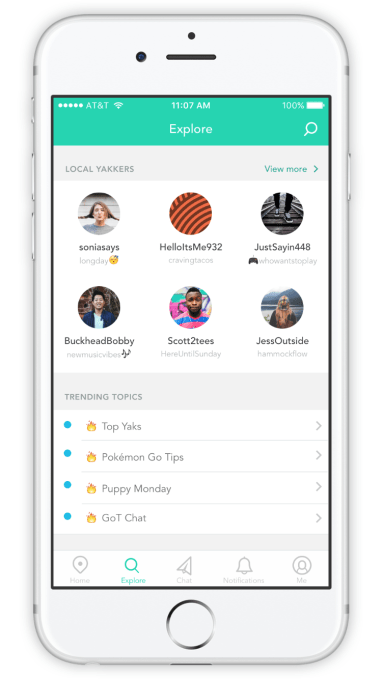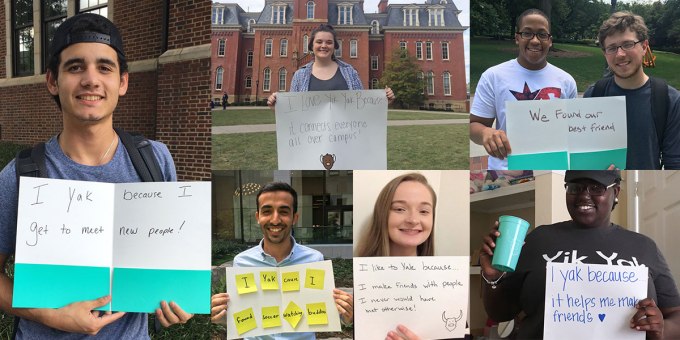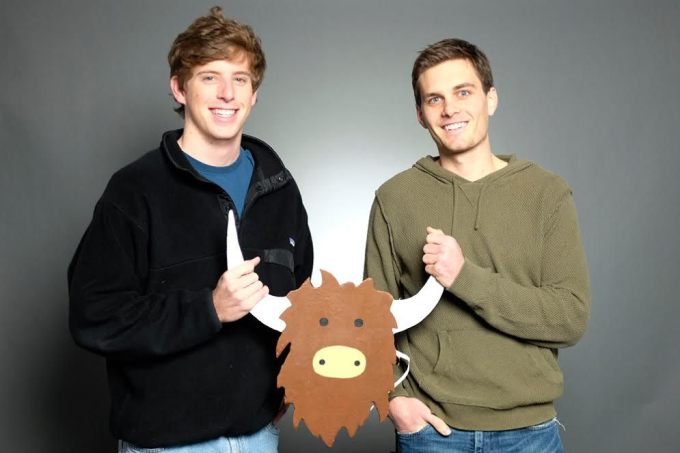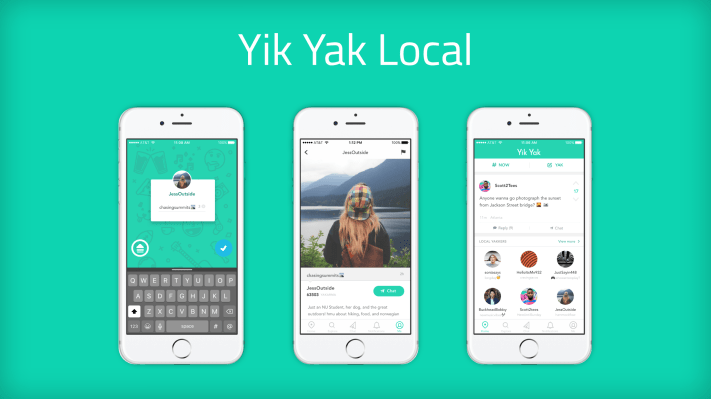Anonymity has proven a dangerous path for startups like Secret, so Yik Yak is pushing a soft pivot towards connection with people close by. You can still share anonymous quips on the sagging college app, but now it’s forcing you to add a handle and photo. Then it wants you to post status updates about what you’re doing that day, and browse and contact nearby Yakkers.
Changing course is critical for Yik Yak, which has declined in monthly users and on the iOS and Android app charts the past two years. It’s no longer red-hot with buzz. Reading anonymous jokes and gripes gets exhausting after awhile, leading to retention problems.
Meanwhile, since its users are mostly college kids sharing in esoteric campus bubbles, Yik Yak falls apart when they leave or summer or graduate. Local features could prove useful for them when they’re home or move to a new city.
Still, teaching an old app new tricks is a struggle. But Yik Yak has to find some way to make good on the $73 million it’s raised thanks to Sequoia. It’s stepping on the turf of Facebook, Instagram, Twitter, Snapchat, and Tinder with today’s update. That’s a pack of apps that’s tough to tangle with.
Yik Yak co-founder and CEO Tyler Droll explains that “The main difference here is the different graph. It’s all about the local graph” opposed to the immediate social graph and celebrities on these other apps. “What bar is everyone headed to across my entire campus? I can get the pulse in my community beyond my really close friend circle” Droll says.
The startup prepped for this shift over the past year with the launch of handles that create identity behind your posts but without your real name, profiles, photos, and finally, chat. Today it made handles and photos mandatory, which might rustle some jimmies.
 With that groundwork laid, it’s not only burying some new features in extra tabs. It’s building them right into the main feed people already use, similar to Instagram Stories.
With that groundwork laid, it’s not only burying some new features in extra tabs. It’s building them right into the main feed people already use, similar to Instagram Stories.
#Now lets Yakkers post 18-character, super-short status updates that disappear in 24 hours. It’s like Snapchat meets Down To Lunch. You could say you’re “studying bio”, “playing frisbee” or “Going to Old Pro” in hopes that other people will show up there too, or message you to meet up. People can see these on your profile or in the #Now tab atop the main feed.
Local Yakkers shows little profile thumbnails of up to 100 people close by atop your home tab and in the new Explore tab (renamed from Herds). This way you can dive into their profiles, see if you have similar interests, and chat them up. It’s sure to become a dating feature, though Yik Yak co-founder Brooks Buffington tells me that’s not the reason it was built.
“If I see someone else is listening to Jamie XX or something, that could resonate with me and I’d want to know more about them. Maybe Jamie XX is about to have a concert near campus and now I can find people to arrive with” says Buffington.
“We’ve never been about anonymity”
A week ago on dreary San Francisco afternoon, I sat by the gray waterfront with Brooks Buffington to discuss Yik Yak’s second act. The cloudy sky mirrored my feelings about Yik Yak. Though once it enjoyed its time in the sun, ominous signals had built up in the anonymous market. How would it emerge from this gloomy season of decline?
“Internally we’ve never been about anonymity” he tells me. In fact, it was just a consequence of a stripped-down sign-up flow. “We just wanted to get people in and experiencing the feed as soon as possible. Anonymity was kind of like a by product of that.”

When asked why he thought Secret failed, Buffington hesitated before noting I don’t know, maybe they grew too fast?” By focusing on college geofences and launching one at a time, Yik Yak had strong reins on its expansion. Yet Buffington admits, “Even then, the way that we’ve grown is overwhelming at some point. There’s a lot of unforeseen things that you have to deal with when you’re gong 100 miles per hour.”
I repeatedly grilled Buffington about Yik Yak’s numbers, which external measurements peg as in decline. He dodged over and over, refusing to reveal any monthly or daily active user counts, and claiming the startup was pleased with its depth of engagement…even if he wouldn’t confirm the drop in number of people engaging.
“To us, DAU isn’t that big of a metric because it fluctuates so widely” Brooks bloviates. “A lot of games have enormous amounts of DAUs but they’re not recreating the same kind of deeper community engagement.”

Yik Yak co-founders Brooks Buffington (left) and Tyler Droll (right)
Today’s update was announced as “Making your world feel small again”. That’s easy when you’re on a cushy US college campus surrounded by people like you. But what Buffington did admit was that “It’s a capped market that we’re in”.
To win big, he understands Yik Yak will need to impress new demographics like college grads and people around the world. It already barred teens by disabling it within high school geofences, so Yik Yak needs to become more serious, not more playful.
Right now, the app’s image is still firmly rooted in anonymous ephemera hurled out by randos in your proximity. This yak must evolve.
